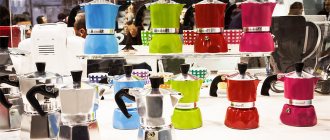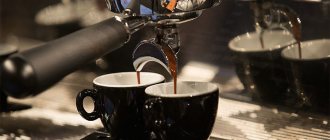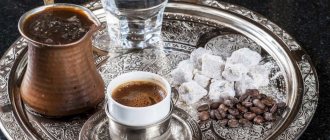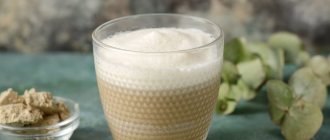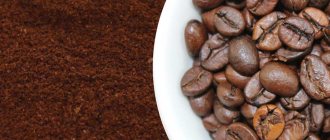Espresso is a strong coffee with a dense texture, thick foam and incredible aroma. It is also the basis for a large number of drinks. Therefore, the final result will depend on how to prepare espresso in a coffee machine.
It has already been proven that preparing espresso is quite difficult, because almost everything can affect the result:
- type of coffee;
- the amount of coffee itself;
- water and its quality.
Italians believe that a person’s professionalism is of minimal importance in preparing a drink.
How to make coffee correctly
The basis of coffee drinks is espresso. According to the recipe, hot water, whipped milk and milk foam are added to it. The components are introduced in strict sequence.
Espresso
Real Italian espresso is strong and invigorating. To prepare, take a good blend of Arabica and Robusta. If the product is not available, mix the grain yourself.
How to make the mixture yourself:
- take 100% Colombian or Brazilian Arabica, dark roast – 1 kg;
- add 100% robusta (Uganda) - 0.25 kg;
- stir the grain;
- The balanced Italian mixture is ready.
A portion of grain must be ground to medium grinding. To prepare, take 30 ml of water. If the machine does not use this amount by default, adjust it in the settings.
Latte
The drink is prepared using 1 part espresso. Add 2-3 parts of milk to black coffee - the volume depends on the taste of the coffee drinker. Complete the recipe with 1 part milk foam.
If the machine does not prepare a drink by default, you can adjust the proportions of coffee and milk in each machine.
Cappuccino
The main thing in this coffee drink is suitable milk:
- Natural, UHT/pasteurized, whole - this product whips best.
- Without boiling, temperature 2-6°C. The warm product hardly fluffs up.
- High in protein - this will give the right, creamy, viscous foam.
- Fat content – 3% and above. The foam will be denser and last longer in the drink.
The second rule is to follow the classic recipe, with the correct sequence of introducing ingredients. The espresso enters the cup first, then the frothed milk.
How to properly prepare coffee in a coffee machine:
- Start brewing espresso (can be replaced with double espresso, ristretto).
- Pour the frothed milk into the same cup.
For whipping, use an automatic cappuccino maker, panarello or a separate frother.
Americano
In the strict sense, Americano is a coffee drink with a volume of 150 ml or more. It is based on espresso or ristretto, diluted with hot water. Many people make the mistake of pouring more water through one coffee tablet. This drink has the right to be called lungo or long black.
How to properly prepare real Americano coffee in a coffee machine:
- Start brewing espresso or ristretto (single or double).
- Add 150 ml boiling water. The drink will be balanced, will receive all the extracted substances, but will become less rich in taste.
If you brew the drink using the Scandinavian method, you will be able to maintain the high foam of the cream. This is done like this: add 60-80 ml of espresso to 120 ml of boiling water.
How to make filter coffee in a coffee machine
Filter coffee is prepared by drip coffee makers - the most affordable coffee equipment for home. The result is a correct, original Americano.
The quality depends on what kind and how much coffee is put into the filter. For exemplary results you need a good product and the right grind. You can take ready-made ground coffee marked “for filter coffee” or “drip coffee machines.”
Taste adjustment:
- Fine grind, large portion of coffee, less water – a strong, rich Americano.
- Coarse grind, smaller batch, larger pour – lighter, waterier taste.
To make good filter coffee in your coffee machine, use freshly ground beans. Use a reusable or disposable filter. Take 8-10 g of powder per serving.
Making cappuccino in a coffee machine
In a nutshell, the cappuccino recipe is simple: add a portion of steamed milk to the espresso. Aspects of manufacturing depend on the type of machine: it is equipped with a manual or automatic cappuccino maker.
Several rules can be considered constant:
- milk for cappuccino should be very rich and, naturally, the freshest,
- It is recommended to cool it, normally up to 5 degrees,
- Tools and parts of the coffee machine that come into contact with milk require impeccable cleanliness.
Prepare espresso, whisk the milk separately and add it to a cup of coffee - that’s a cappuccino. If the drink is prepared correctly, then a small spoonful of sugar may remain on the foam.
Setting the grind for your coffee machine
An important part of the settings is the basis of its intensity and richness of the drink. Typically, the degree of processing is set based on the characteristics of the coffee bean. The smallest one will force you to reveal all the inherent nuances of taste; in addition, a higher foam of the cream will be formed.
How to set the grind level in a coffee machine:
- Espresso – volume up to 40 ml. Fine grinding will extract more sourness from the grain, medium grinding will make the drink more balanced and neutral. This is also true for ristretto.
- Double espresso, lungo – from 40 ml. Coarse grinding will give more sourness, fine grinding will give more bitterness.
General recommendations are to use a coarser grind for larger volumes of coffee and dark roasted beans. Small will cause the drink to become bitter. Coarsely ground lightly roasted grains will not reveal the taste in any way. For beginners, it’s best to start with a medium grind. After preparing the drink, you can adjust the parameters in one direction or another.
When learning how to properly prepare coffee in a coffee machine, consider the following nuances:
- Drink volume. When more water is poured through a shot of coffee, the taste becomes distinctly bitter and the caffeine level increases. A smaller volume gives richness and obvious sourness. Form final flavor notes depending on the type and volume of the drink.
- Strength adjustment. The parameter reflects the amount of ground powder per serving. The more grain the machine sweeps, the richer, brighter, stronger the taste will be.
Coffee machines have a pre-wetting function. It pauses the first stage of pouring water through the coffee tablet. This makes the powder uniform and dense. By adjusting the pre-wet from 1 to 3 seconds, a more flavorful drink will flow into the cup.
Algorithm of operation of an automatic coffee machine
- Grinding beans into coffee powder in a hopper (if coffee is beans).
- Loading the required amount of ground coffee into the receiver, pressing.
- Passing prepared boiling water under pressure through ground coffee, while the resulting drink is poured through the dispenser nozzles into a cup.
- Discharge of spent powder into a waste tank.
For home use, a semi-automatic machine is most often purchased. Thanks to some functions that you have to perform manually, this coffee machine will make you feel like a real coffee specialist (barista).
Tips for caring for your coffee machine
Making coffee correctly in a coffee machine is not enough - all coffee equipment needs to be descaled. The correct and only correct sequence of actions is described in the instructions for the device. There are no universal solutions - each model has its own buttons and keys for decalcification.
Use a cleaner for automatic coffee machines (liquid or tablet), following the proportions indicated on the bottle. It is not recommended to use vinegar and citric acid. The need for decalcification is indicated by an indicator or message on the device screen.
The second stage of care is cleaning the brewing unit. The unit requires removal of coffee oils. Recommendations:
- Express wash. Remove and wash the removable device under running water every 1-3 weeks. Place the block back into the car when it is dry.
- Use coffee oil cleansing tablets. The frequency depends on the intensity of use. The machine itself will give a signal using the indication.
- Lubricate the block regularly - once every 4 months.
The third stage is cleaning the milk circuit. For severe contamination, use special products for cappuccino makers. Periodically wash all parts of the device under the tap or in the dishwasher. Use the automatic built-in program to clean the milk system.
Making a latte in a coffee machine
Latte is another coffee-milk drink, but the ratio of ingredients changes in favor of milk: there is three times more of it. The frothed milk is poured into a large glass and a shot of espresso is added, making sure that they do not mix. The result is a three-layer cocktail: milk at the bottom, coffee in the center, and milk foam on top. Syrups are often added to this drink, which add a fresh taste of vanilla or fruit.
Making truly delicious coffee is impossible without a good coffee machine. It must provide the required pressure, whisk the milk normally and correctly combine it with the base. offers free rental of a coffee machine for the office. With us you can choose a machine that is tailored to your needs.
How to make espresso in a coffee machine.
Even more expensive coffee machines will not prepare coffee without the help of others. Therefore, in order to enjoy tasty and fragrant espresso once a day, it is recommended to familiarize yourself with the technology of its production.
Choosing coffee for a coffee machine
The main selection criterion is the roasting time. High-quality grains were roasted no more than 3-4 weeks ago. Manufacturers can supply such a product to coffee chains and specialty stores - here you can buy a good blend.
In addition, evaluate different types of beans, select the ratio of Arabica and Robusta. To choose your blend, take several mixtures to try.
Reference point:
- Arabica determines 99% of the flavor nuances. The higher the variety is harvested, the more intense and dense the taste.
- Robusta determines the quality of the cream foam, the level of strength and bitterness. The variety has a higher caffeine content and no sourness.
It is good to use a single variety. Such grain grows in a certain area, in one country, and gives uniform flavor notes. Choose a medium or dark roast. The first is typical for espresso, the second will give more strength and a characteristic caramel-bitter aroma.
What coffee to use for a carob coffee maker
Coffee for a carob coffee maker should not be old - it dries out and stops absorbing liquid. The main thing is to form the coffee tablet correctly. In this case, it will absorb all the water and prepare a real drink.
To brew coffee professionally, you need to try to fill the entire horn (80-90%) and temper the powder well. When working with beans, it is better to set the coffee machine to medium grind. Medium roast is preferred.
Caffe Latte
Caffe Latte is translated from Italian as “coffee with milk”. There are two types of Latte coffee: Latte and Latte Macchiato. The difference is that in the first case milk is added to the coffee, and in the second case coffee is added to the milk. To make a latte, boil double espresso and mix it with hot milk (approximately 130 ml). The drink is served in a tall glass or large cup. Coffee syrup is often added to lattes. If desired, the drink can be decorated with whipped cream.
Common coffee making mistakes
Caramelized, flavored beans cannot be used in coffee machines. Additives coat the coffee grinder millstones with a film, and the grinding suffers. They are difficult to clean; often you have to disassemble the entire assembly. It is also undesirable to use ground coffee with additives.
A typical mistake is incorrectly setting the grinding degree in a coffee machine for a specific roast of beans. Dark prefers coarser grinding and vice versa. The universal solution remains medium settings.
Bottled mineralized water with added calcium, fluorine, and iodine has a bad effect on the quality. Take simple filtered water without chlorine, color, or odor.
Espresso (Espresso)
To make your favorite cup of espresso, you need to pass boiling water through approximately 10 grams of ground coffee under high pressure. Served in demitasse (warmed cups with thick walls), 2/3 filled. Regular espresso delights with its breathtaking softness, catchy aroma and gentle foam. There are several types of traditional espresso: Ristretto (more intense), Lungo (least intense) and Doppio (double espresso).
General concepts
Why are proportions important? The taste of coffee depends very much on the recipe. The amount of each ingredient used in a recipe matters. By increasing or decreasing the volume of water and coffee, you can change the taste, richness, etc. This provides an opportunity for experimentation in order to ultimately obtain a drink with the desired characteristics. Here you need to remember that you should make changes only to one component at a time, so as not to get confused. Once you find your optimal ratio, you can repeat making the same coffee in the future. Accurate electronic scales are best suited for measurements. You can, of course, use a teaspoon, or count the grains by quantity, but in this matter the decisive factor is weight, not volume. Therefore, to be efficient, most baristas use precision measuring instruments such as scales and a timer. Is there an ideal ratio of coffee to water? This question was asked in the USA back in the 50s of the last century. The Coffee Brewing Institute conducted a series of studies asking many coffee drinkers to learn about their tastes. The research was led by MIT chemistry professor Ernest Earle Lockhart. As a result of this work, recommendations for brewing coffee and the Coffee Brewing Control Chart were born. The chart shows the optimal extraction (recovery of soluble solids) and strength (total dissolved solids) values for the coffee Americans prefer. According to the Specialty Coffee Association of America, not much has changed since then.
Mocaccino (Moccacino, mocha cappuccino)
Unlike other coffee varieties, moccacino originates from America, although it has an Italian name. It is also known in the world as chocolate latte. Its characteristic feature is the presence of chocolate, cocoa or chocolate syrup mixed with one part espresso and 2 parts hot milk.
Having a coffee machine certainly simplifies the making of coffee, making it richer and more fragrant due to the fact that the beans are crushed just before making the drink. In addition, a certain pressure and the required temperature are maintained. Experiment with flavors, maybe your recipe from a coffee machine will be as good as regular Italian espresso.
Proportions
The graph shows that European tastes are somewhat different from American ones. But this is still a fairly accurate, scientific approach that requires a special device - a refractometer - to measure TDS (extraction level). This topic deserves a separate article, let's talk about a simpler approach. Along with the Coffee Brewing Control Chart, the Specialty Coffee Association also offers the Golden Cup standard. It assumes a coffee to water ratio of 1:18, which is not suitable for all brewing methods. For example, preparing espresso takes a short period of time (about 25-30 seconds) and uses very little water. To calculate the ratio, the formula is used - dose of coffee multiplied by 1.5-2.2 = yield of the finished drink. Thus, if we take 18 g of coffee, we should get a drink with a volume of 27 to 39 g. In such proportions, the large number is always water, since coffee mostly consists of it. That is, if the ratio is 1:15 or 15:1, then 10 grams of coffee are taken per 150 grams of water or 7 coffee per 105 grams of water. Mathematics! It's better to have a calculator on hand. If we talk about other methods of preparation, such as the French press, Aeropress, pour over, drip coffee maker and others, the cooking time here is much longer, and accordingly more water is used. For types of brewing such as drip and pour-over, the proportional range ranges from 1:15 to 1:18; for the rest of the above, the extreme points are 1:10 and 1:20. At a ratio of 1:10 the drink will be extremely strong, and at 1:20 it will be weak and diluted. Here you need to find your proportions so that all the notes and features of the finished drink satisfy your taste. The starting point for Turkish coffee is the following: 1:12, this is classic Turkish coffee, then you should base it on your own preferences and a specific recipe. This ratio of coffee to water is also true for preparing a drink in a geyser coffee maker (moka). Good luck with your experiments!
YouTube tutorial videos and our coffee patrols.
Сappuccino (Cappuccino)
Cappuccino is considered a milk-coffee drink. In the traditional recipe, espresso, warm milk and milk froth are mixed in proportions of 1:1:1. When serving a drink, decoration is of great importance: small cups, grated chocolate, cinnamon, vanilla, cocoa, nutmeg - for any taste. Coffee syrup will give the drink a special smell. If you have a modern coffee machine with a cappuccino function, then making drinks will not take much time.


